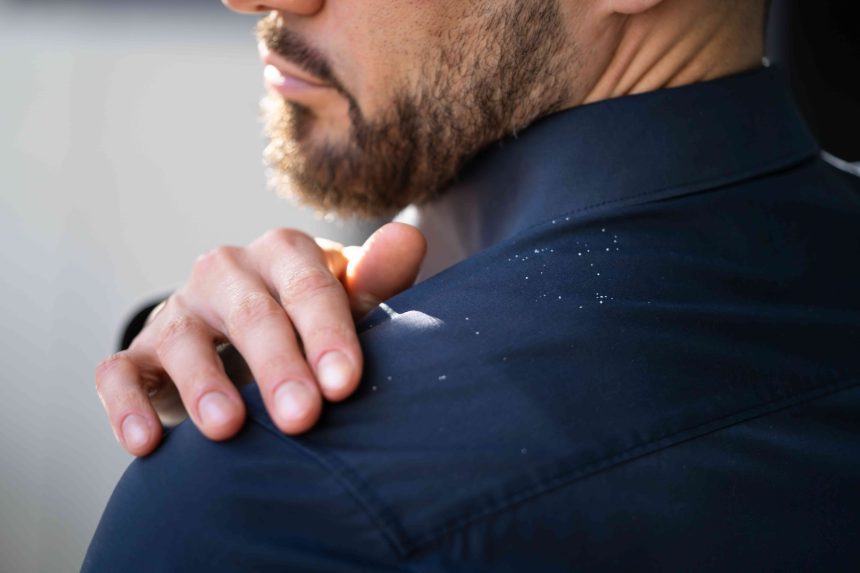Dandruff is a common skin condition that causes the skin on the scalp to flake off. Possible signs of dandruff include white or yellow flakes (dead skin cells) on the hair and shoulders. This condition is usually mild and is not contagious.
Common causes of dandruff include scalp dryness, oily skin, or a fungal infection. Anyone can experience dandruff, and adolescents may be at higher risk because their scalps produce more oil than other age groups.
The types of dandruff are based on the underlying cause. It is essential to determine the cause of the condition so you can get the proper treatment.
Cause: Chronically dry skin is a common cause of dandruff. When the scalp is dry, the skin becomes irritated and starts to flake off. Dandruff from dry skin is most common in the winter because the colder weather can dry out the skin. Washing the hair too often can also cause the scalp to become too dry.
Symptoms: Dandruff from dry skin usually looks like small, white flakes. A dry scalp often feels itchy.
Treatment: To treat or prevent dry skin dandruff, avoid washing your hair every day. Use a gentle, fragrance-free shampoo every few days. There are also over-the-counter (OTC) dandruff shampoos available for this type of dandruff.
Cause: The glands under the scalp produce oil called sebum. When excess sebum clumps together on the scalp, it irritates the skin and leads to dandruff. A severe form of oily skin dandruff is seborrheic dermatitis. This is a common skin condition that causes dandruff and red, scaly patches on the scalp.
Symptoms: Dandruff caused by oily skin often appears yellow. The flakes may look larger than the small, white flakes of dry dandruff. If you have oily dandruff, your hair may look oily and stringy.
Treatment: To treat an oily scalp, shampoo your hair regularly to remove excess sebum. Letting the shampoo sit for five minutes before rinsing may help even more.
Cause: A common yeast-like fungus called Malassezia may cause dandruff. This fungus is on everyone’s skin and does not usually cause symptoms. However, some people experience an inflammatory response to the fungus that causes scalp irritation and dandruff. Malassezia grows quickly when there is an excess of sebum (oil) on the scalp. People prone to oily skin may be at higher risk for an overgrowth of Malassezia.
Symptoms: Fungal dandruff may appear as yellowish flakes and oily hair.
Treatment: Dandruff from Malassezia is treatable with shampoos that contain zinc pyrithione to prevent fungal growth.
You can see which type of dandruff you have by examining the flakes. Oily and dry flakes look different. You can also see if you have other symptoms of either type of dandruff, such as dry scalp or oily hair.
Fungal dandruff can appear similar to oily dandruff. If a healthcare provider is unsure whether Malassezia is causing your dandruff, they may request a culture (though it’s not routine). A culture involves taking a sample of the dandruff and testing it to look for the fungus.
A dermatologist (a doctor who specializes in conditions of the skin, hair, and nails) can often confirm the type of dandruff you have just by looking at your dandruff, scalp, and hair.
Most cases of dandruff are mild and can be treated at home. Consider seeing a healthcare provider if you experience dandruff with any of the following symptoms:
- Scalp redness and irritation
- Patches of dry or scaly skin
- Intense itching
- Dandruff that does not improve after treatment with dandruff shampoo
Dandruff is a common condition, and using a dandruff shampoo typically cures the condition. To prevent dandruff, consider taking the following precautions:
- Wash your hair every few days to prevent sebum buildup
- Avoid daily hair washing because that could dry out the scalp
- Use gentle, fragrance-free shampoos and conditioners
- Apply conditioner only to the hair ends and not the scalp
- Use a hairdryer on a cool (rather than hot) setting if your scalp is dry or itchy
Dandruff is a common skin condition that causes the scalp to become irritated and flake off. The flakes of dead skin can often be seen on the hair and clothing.
The appearance of the flakes can depend on the type of dandruff you have. Dry dandruff flakes may appear small and white, while oily or fungal dandruff flakes may look large and yellow. Besides the flakes, whether your hair is oily or dry may also indicate what type of dandruff you have.
In most cases, an OTC dandruff shampoo effectively treats dandruff. If at-home treatments are ineffective, see your healthcare provider.







